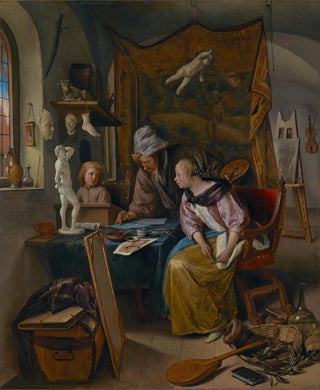Art print | The Drawing Lesson - Jan Steen


View from behind

Frame (optional)
Dive into the vibrant world of 17th-century Dutch art, "The Drawing Lesson" by Jan Steen stands as a lively testament to the daily life and customs of its time. This piece, both playful and educational, invites us to observe a classroom scene where the art of drawing is celebrated. The characters, skillfully arranged within a typical interior, embody the dynamic between the teacher and students, while revealing the subtleties of pedagogical methods of the era. The richness of details and the liveliness of expressions captivate the viewer, offering an intimate glimpse into human interactions and learning.
Style and uniqueness of the work
The strength of "The Drawing Lesson" lies in its baroque style, characterized by a play of light and shadow that gives a striking depth to the scene. Jan Steen, master of visual storytelling, manages to capture not only the essence of the characters but also the atmosphere that prevails in this classroom. The vibrant colors, exaggerated gestures, and facial expressions of the students convey a joy of learning, but also a certain disorder, reflecting human nature. Every element of the composition, from scattered books to drawing instruments, contributes to creating a lively and dynamic ambiance. This work is rooted in the tradition of genre painting, but it stands out for its ability to combine humor and reflection on education, a universal and timeless theme.
The artist and his influence
Jan Steen, born in 1626 in Leiden, is one of the most emblematic painters of Dutch painting. His work is characterized by a realistic and often satirical approach to daily life, depicting scenes of bourgeois life with remarkable acuity. Influenced by masters such as Rembrandt and Frans Hals, Steen develops a style that is uniquely his own, blending narrative liveliness with psychological depth. His skill in capturing human emotions and telling stories through his paintings has left an indelible mark on European art. The themes of education and learning, present in "The Drawing Lesson",

Matte finish

View from behind

Frame (optional)
Dive into the vibrant world of 17th-century Dutch art, "The Drawing Lesson" by Jan Steen stands as a lively testament to the daily life and customs of its time. This piece, both playful and educational, invites us to observe a classroom scene where the art of drawing is celebrated. The characters, skillfully arranged within a typical interior, embody the dynamic between the teacher and students, while revealing the subtleties of pedagogical methods of the era. The richness of details and the liveliness of expressions captivate the viewer, offering an intimate glimpse into human interactions and learning.
Style and uniqueness of the work
The strength of "The Drawing Lesson" lies in its baroque style, characterized by a play of light and shadow that gives a striking depth to the scene. Jan Steen, master of visual storytelling, manages to capture not only the essence of the characters but also the atmosphere that prevails in this classroom. The vibrant colors, exaggerated gestures, and facial expressions of the students convey a joy of learning, but also a certain disorder, reflecting human nature. Every element of the composition, from scattered books to drawing instruments, contributes to creating a lively and dynamic ambiance. This work is rooted in the tradition of genre painting, but it stands out for its ability to combine humor and reflection on education, a universal and timeless theme.
The artist and his influence
Jan Steen, born in 1626 in Leiden, is one of the most emblematic painters of Dutch painting. His work is characterized by a realistic and often satirical approach to daily life, depicting scenes of bourgeois life with remarkable acuity. Influenced by masters such as Rembrandt and Frans Hals, Steen develops a style that is uniquely his own, blending narrative liveliness with psychological depth. His skill in capturing human emotions and telling stories through his paintings has left an indelible mark on European art. The themes of education and learning, present in "The Drawing Lesson",






